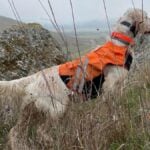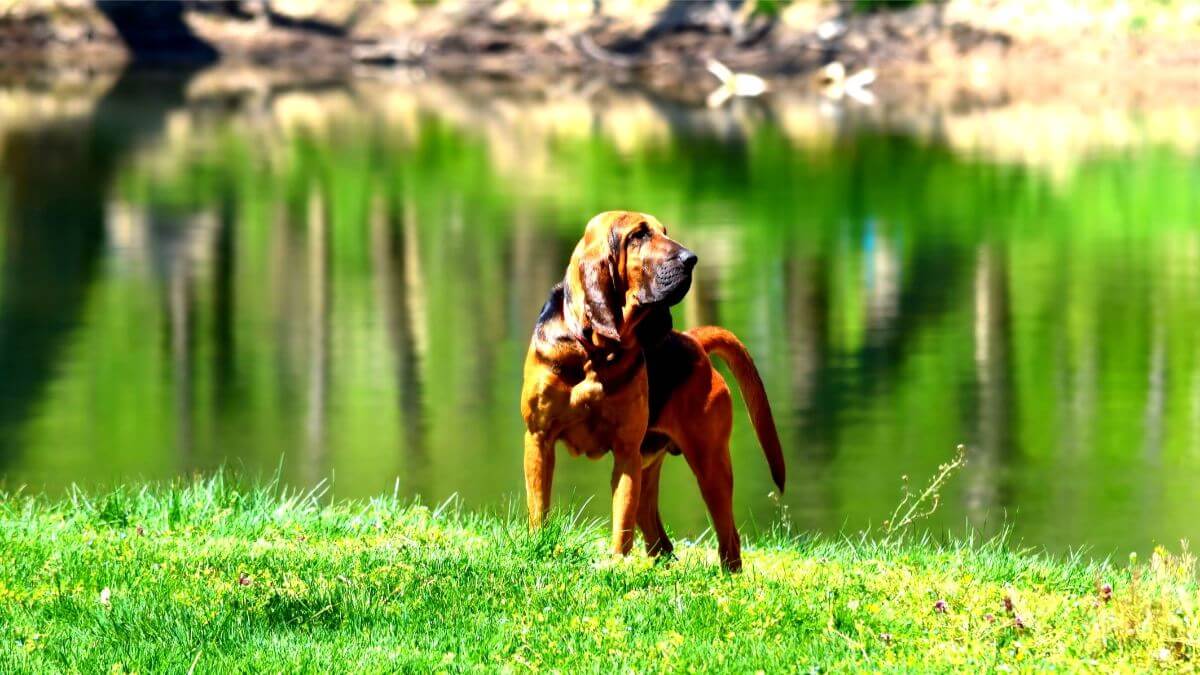
Home » Judging the Bloodhound

This article was originally published in Showsight Magazine, November 2011 issue.
Our first look at your class of hounds is holistic, checking for correct size, silhouette, and proportions. The Bloodhound is not square but rectangular or off-square, “stands over more ground than is usual with other hound breeds.”
Your first impression should be of a strong and powerful dog because his job requires endurance to trail in all kinds of weather for hours over all kinds of challenging terrain, from rugged mountains to paved parking lots. Bone and substance are important to the successful working Bloodhound—do not reward light bone.
(Although for simplicity, I refer to the hound as “he,” some of our great show dogs and working hounds have been bitches.)
The height and weight figures in the standard are not requirements but describe an average: 26 inches for adult dogs, 24 for adult bitches, 90 pounds for adult dogs, and 80 pounds for adult bitches. The standard does not say “the bigger, the better,” but that the greater heights and weights are to be preferred if character, proportion, and quality are equal.
For whatever reason, the Bloodhounds in your ring today will be taller and heavier than the figures in the standard. Bear in mind that these dogs are worked in harness and on a lead, pulling the handler behind, and that they may need to be assisted over walls or fences.
The head of the Bloodhound is important to both the working function and the breed type of the hound. Accordingly, more than one-third of the standard addresses the head and neck. The nose, the ears, the wrinkle, even the notorious slobber all serve to enhance scenting ability. All dogs scent, but the Bloodhound is supreme in his ability to discriminate one scent from all others.
When the Bloodhound drops its head to the trail, the wrinkles and ears form a cup around the nose with its large, open nostrils. For this reason, the superabundant thin, loose skin is desirable on the head and neck. There is no justification for festoons of skin on the hindquarters and problems.
In a standard notably lacking in specifics, the length of the head is specified as 12 or more inches in dogs and 11 in bitches. Narrow in proportion to length and long in proportion to the body, the head is about the same width throughout and appears flattened at the sides. Of course, the head must complement the rest of the dog, and a bulky male can carry a broader head if the length is present.
The planes of the foreface and the back skull should be nearly parallel. Unfortunately, in today’s hounds there is a distressing prevalence of receding back skulls. When the back skull falls away, there can be neither parallel planes nor pronounced occipital peak. The length of the muzzle should not be less than that from the stop to the occipital peak, which should be very pronounced.
Viewed in profile, the foreface should have a square outline, not pointed or snipey. The correct head is truly aristocratic, the back skull a pointed oval, never round, broad, or coarse. The eyelids form a diamond-shaped eye. A round eye creates a bold look, not the characteristic sad, pleading hound expression.
A red haw should not be penalized as long as the eye looks healthy. The eyes complement the color of the dog, ranging from dark brown or hazel to yellow in liver and tans. Ears are extremely long, soft, and velvety, set on at least as low as the eye, falling in graceful folds which curl inward and backward. The large open nose is black or brown, corresponding to the color of the hound. A scissors bite is preferred; a level bite is acceptable.
Keep in mind that the Bloodhound is worked in harness on a lead. He is not encouraged to run because he is attached to his handler. Adequate balanced angulation front and rear is essential to the resilience required for his job. A long neck and well-laid back shoulders allow the hound to drop his head comfortably to the trail.
Although the standard does not specifically mention the prominent prosternum that is desired, it goes with well-laid back shoulders. As the song says, “You can’t have one without the other.” Don’t let neck skin fool you about neck length and shoulder layback. There will be two or three fingers’ width between the shoulder blades because this is a dog that works with his nose on or near the ground.
When the head moves down, the blades move closer together, and there must be room for this. The chest is deep, extending in a mature hound to the elbows, allowing ample room for heart and lungs.
The body is of uniform depth throughout with little or no tuck-up. Hounds, particularly bitches, may have a “dust ruffle,” a fold of skin hanging down underneath, which may give the illusion that the hound is overweight or short on leg. Actually, the standard does not address length of leg in relation to height at the withers as many standards do. Let pleasing proportions be your guide.
In my experience as a breeder, most Bloodhound bitches have false pregnancies, and I would not fault this in the show ring. My Basset breeder friend Peg Walton used to say, “Any fool can see what that is.”
Forelegs are straight and large-boned; thighs and second thighs are muscular with well-let-down rear pasterns. Back and loins must be strong. Fault a weak or dippy topline. The standard is clear that feet should be strong and well-knuckled, an important feature for a working hound.
In movement, demand a fit, athletic animal with a well-balanced, coordinated gait. Going away, the Bloodhound may move wide for the first few steps, but when in gear should move neither close nor wide. There should be no wasted motion, no hackney gait, no paddling, no crossing over.
The stern is long and tapering, set on rather high. Ideally, it should be curved like a sickle, but you will find departures from the ideal. The tail is important to the silhouette, not so much to the working function. Use your judgment.
Temperament also is related to the Bloodhound job description. Not particularly obedient or tolerant of demands for repetitive behavior, the Bloodhound is a stubborn and independent problem-solver. Following a scent, he will find a way to go over, under, or around obstacles.
The standard describes him as affectionate, not quarrelsome, somewhat shy, and sensitive. I would use the word “reserved” rather than put the stamp of approval on shyness. Because of the hood of skin, some hounds do not see very well and some are very sound sensitive. Also, some are surface sensitive—you would think that the duct tape on the mats was a barrier.
Be sure to approach Bloodhounds from the front, let them smell your hand, and speak to them. Be confident, not tentative, but please don’t be rough. You don’t need to grab the skin and wave it around to know it is there. Although you should cut a sensitive youngster some slack, exert zero tolerance to a hound who is threatening in any way.
Judges cannot go wrong if they emphasize the functional characteristics, give less consideration to other features, and acknowledge that there are some areas where they must make a judgment call.